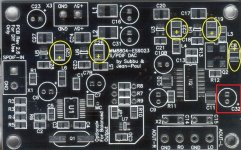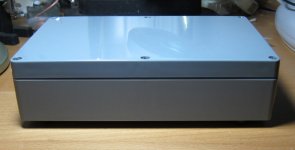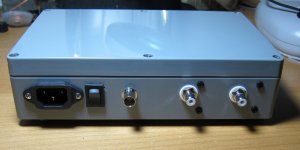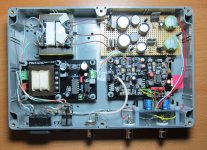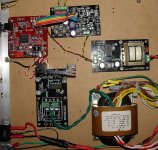Hi Tome, no measured or even heard humm from the 230 V wiring crossing the output section of the DAC ? Unshielded L + R wiring and 230 V wiring is a big no no in general. You could use 4 extra standoffs and mount an iron sheet connected to PE between the DAC PCB and the wiring.
Advice: I would turn the DAC PCB 180 degrees to the right and also turn the output cover 180 degrees. That way 230 V wiring is centimeters away from the outputs. Then swap the SPDIF and 230 V inputs. So SPDIF (then required) shielded coax wiring will be going over the DAC PCB "ïn the air". That way you will have a technically better performing and measuring device. Very likely also better sounding because of that. Nice looking work though. You see that the designs were meant for wide cases and not narrow and deep cases, sorry for that. In narrow and deep cases probably the power switch is best placed at the backside of the case. Unconvenient but electrically better.
C13 is a nice extra that does not cost a lot.
Advice: I would turn the DAC PCB 180 degrees to the right and also turn the output cover 180 degrees. That way 230 V wiring is centimeters away from the outputs. Then swap the SPDIF and 230 V inputs. So SPDIF (then required) shielded coax wiring will be going over the DAC PCB "ïn the air". That way you will have a technically better performing and measuring device. Very likely also better sounding because of that. Nice looking work though. You see that the designs were meant for wide cases and not narrow and deep cases, sorry for that. In narrow and deep cases probably the power switch is best placed at the backside of the case. Unconvenient but electrically better.
C13 is a nice extra that does not cost a lot.
Last edited:
Sorry for my late reply but I wasn't active on Diy forum last month.
Yes i built one and here is pics for my near finished DAC. I use Hammond aluminium case and I'm very happy with results.
Tome,
It looks like you missed the discussion about the correct polarity of C32. It should be opposite of what you've done, as shown in the attached picture. I borrowed the picture from the DAC build thread and don't recall who made the excellent diagram, but all credit for the picture goes to him.
---Gary
Attachments
Sharp eyes Gary !
JP,
Thanks. By the way, I took your advice and rewired my DAC to shorten the AC wiring length and get it further away from the DC output. It looks nicer but to be honest I can't tell any difference in the sound. With trepidation, I've attached a few more pictures. You'll frown at the exposed 120v terminals, but I only run this with the cover on, so I'm willing to run that risk.
---Gary
Attachments
JP,
Thanks. By the way, I took your advice and rewired my DAC to shorten the AC wiring length and get it further away from the DC output. It looks nicer but to be honest I can't tell any difference in the sound. With trepidation, I've attached a few more pictures. You'll frown at the exposed 120v terminals, but I only run this with the cover on, so I'm willing to run that risk.
---Gary
Hi,
What is that you have between the dac ouytput port and the RCA?
Hi,
What is that you have between the dac ouytput port and the RCA?
A JG Filter/buffer. See this thread for more details http://www.diyaudio.com/forums/group-buys/216669-joachim-gerhard-filter-buffer-es9022.html
---Gary
Gary how does it sound from an objective point of view ? Was the work worth all the effort ? And how does it compare to commercial DACs or other DACs you may have ?
Shielding still is recommended with regard to the 50 MHz XO etc. You can experiment with shielding of just the DAC board. A metal case within the plastic case so to speak. Conductive shielding spray painting the inside of the plastic casing also is a solution but then exposed wiring might cause unexpected surprises
I am impressed you were willing to listen to advice and improved the build of your DAC. Kudos.
Shielding still is recommended with regard to the 50 MHz XO etc. You can experiment with shielding of just the DAC board. A metal case within the plastic case so to speak. Conductive shielding spray painting the inside of the plastic casing also is a solution but then exposed wiring might cause unexpected surprises
I am impressed you were willing to listen to advice and improved the build of your DAC. Kudos.
Last edited:
Gary how does it sound from an objective point of view ? Was the work worth all the effort ? And how does it compare to commercial DACs or other DACs you may have ?
Shielding still is recommended with regard to the 50 MHz XO etc.
JP - thanks for the continued feedback and interest. This is actually the 2nd DAC I built with the Subbu v2.6 board. The first one was built in a die cast aluminum box and used a handwired JG buffer and different power supplies. The one in the die cast box sounds better with the top off, which made think that putting the 2nd one in a non-metallic box might be an improvement. See Gary's build
Until today, the first one in the metal box sounded slightly better than the 2nd one, but there are lots of differences between the builds, so it's not a clean experiment. The first uses a 5v supply consisting of an LM317 followed by an FET cap multiplier with the voltage set by a current source driving a resistor. The 2nd uses the 5v supply you designed. The first JG buffer +- 15v supply used LM317 regulators with tracking preregulators vs. the LT1963's used in the 2nd build. And there were differences in the JG buffer - hardwired in the 1st build vs. the EUVL buffer board in the 2nd. So it's hard to attribute the changes between the two to just shielding vs. no shielding. I noticed that the EUVL buffer board used 10 ohm resistors at the +- V inputs to slightly isolate left and right channels. I just shorted those out today, so I'm re-comparing the two builds to see how that changes things. First impressions seem to show it's better with the 10 ohm resistors shorted and that seems to tilt things in favor of the 2nd build with your power supply and the EUVL buffer.
In terms of comparisons to other DACs - here is what I've compared it to. All comparisons are in SPDIF mode.
1) ES9018 DAC (Buffalo III) with outputs run in current mode by putting low value resistors across output and then converting differential output to SE with Sowter 1:18 transformers followed by a cascoded jfet buffer. This is now my reference DAC and sounds better than the Subbu dac with JG filter/buffer but at much great cost.
2) Mytek DSD 192. In SPDIF mode, the Mytek is only OK and I like both the Buffalo III and the Subbu DAC better.
I've got some other older DIY DACs around but haven't had a chance for detailed comparisons.
---Gary
Last edited:
JP - thanks for the continued feedback and interest. This is actually the 2nd DAC I built with the Subbu v2.6 board. The first one was built in a die cast aluminum box and used a handwired JG buffer and different power supplies. The one in the die cast box sounds better with the top off, which made think that putting the 2nd one in a non-metallic box might be an improvement. See Gary's build
I try to keep up with your DACs but it seems I was mixing things up. Glad to see you use 75 Ohm BNC connectors for SPDIF.
First impressions seem to show it's better with the 10 ohm resistors shorted and that seems to tilt things in favor of the 2nd build with your power supply and the EUVL buffer.
Good to know that the PSU lives up to the expectations. Talking about drawing conclusions based on false preconceptions
1) ES9018 DAC (Buffalo III) with outputs run in current mode by putting low value resistors across output and then converting differential output to SE with Sowter 1:18 transformers followed by a cascoded jfet buffer. This is now my reference DAC and sounds better than the Subbu dac with JG filter/buffer but at much great cost.
---Gary
ES9018 is not a fair comparison (which does not prevent from comparing of course) but still... the Subbu DAC probably costs less than one of the Sowthers... How much better is the ES9018 ? Simply significantly better or slightly better like let's say 5 % ? And how do prices compare so what did the ES9018 DAC cost to build if I may ask ?
I know most of us are always trying to find better sounding equipment but sometimes it can be refreshing to look at the price/performance ratio. I think the Subbu DAC gives a lot for what it costs. I can live with it and have no wish for better DACs that cost 10 times as much and sound just a tad better for instance. This gives me a remarkable sense of being satisfied and it gives the freedom to build amps again. My personal opinion is that it is a device that can be enjoyed with no real drawbacks. Way better than most of the stuff I tried in the past.
Last edited:
Just looked up the Mytek. Boy what fun it is to know our Subbu DAC V2.6 is better than a DSD DAC (with more advanced Sabre chip) that retails for 1695 US $ !
"Plain affordable and reliable stuff designed to sound good", it was like that in the golden age of HiFi and it still is possible in 2013. I am as curious as some of you how the PCB's for V3 turn out. We are waiting for those now.
Some news: the PSU PCB will be changed to a new revision. Details will follow later.
"Plain affordable and reliable stuff designed to sound good", it was like that in the golden age of HiFi and it still is possible in 2013. I am as curious as some of you how the PCB's for V3 turn out. We are waiting for those now.
Some news: the PSU PCB will be changed to a new revision. Details will follow later.
Last edited:
Quoting Flounder in Animal House: "oohh boy, this is great!"...Some news: the PSU PCB will be changed to a new revision. Details will follow later.
ES9018 is not a fair comparison (which does not prevent from comparing of course) but still... the Subbu DAC probably costs less than one of the Sowthers... How much better is the ES9018 ? Simply significantly better or slightly better like let's say 5 % ? And how do prices compare so what did the ES9018 DAC cost to build if I may ask ?
The Bufffalo III + SPDIF board + shunt power supply + power transformer is about $500. Add on top of that the output transformers and the power supply and output buffer. I got the output transformers in trade so they didn't cost me much. But to build this from all new parts would easily cost between $700 and $800 - maybe more if I accurately counted everything. The chassis is homemade out of plywood and oak
Even so, it does sound significantly better than the Subbu DAC + JG filter/buffer, which in my opinion is also a good step up from just the Subbu DAC. Of course, tweaking the JG filter/buffer has closed the gap - it remains to be seen how much. I'll report back at a future date.
Regarding the question of shielding, it's not that I don't understand your point. I completely understand. I've been a ham operator since I was 12 years old and I've got degrees in EE. It's just that I'm not sure that I agree. The wavelength of a 50Mhz signal is 6 meters. I just don't think we'll be seeing a lot of radiation from the small traces on the boards. The much more likely source of 50Mhz noise is through the power supply and ground lines. And shielding will not have much impact on this at all. Assuming that you and Subbu have done a good job laying out the board and dealing with ground then I think things probably work fine without shielding. Of course, I'm always open to new information, so if you've measured significant changes in 50Mhz clock noise coming out of the DAC with shielding then I'm willing to change my opinion. In fact, I've got a good 100Mhz scope so I may poke around and see what I can measureBTW shielding is not a case of listening. It must be shielded as it contains a 50 MHz XO. You can listen to different caps and such but electronics with high frequency components just must be shielded.
---Gary
Hi there should be a difference with such a lot of engineering, cost and a chip that is the ES9023 big brother. It would have been truly unbelievable if the Subbu V2.6 would have been better than a full grown well designed ES9018 DAC. That is why I am surprised that the Mytek sounds less good. That one has a good reputation.
Regarding the shielding: I had problems with the very first version V0 which is why the coils and later the beads have been added. I clearly measured 50 MHz on the supply lines. Also the open PCB (with long wiring as it was a test example) was sensitive to a cell phone that was laying on the desk. With the V2.6 you will not see that.
Probably a european thing: if it should be like that it must be done like that. Makes life simpler and more organized.
Regarding the shielding: I had problems with the very first version V0 which is why the coils and later the beads have been added. I clearly measured 50 MHz on the supply lines. Also the open PCB (with long wiring as it was a test example) was sensitive to a cell phone that was laying on the desk. With the V2.6 you will not see that.
Probably a european thing: if it should be like that it must be done like that. Makes life simpler and more organized.
Last edited:
Jean Paul,. . . It would have been truly unbelievable if the Subbu V2.6 would have been better than a full grown well designed ES9018 DAC. That is why I am surprised that the Mytek sounds less good. That one has a good reputation.
I was also surprised that the Mytek wasn't better. It certainly wasn't bad but didn't knock me out the way I'd expected based on all the glowing reviews. My experience playing with the Buffalo III was that the ES9018 sound is really dependent upon the quality of the output stage. It sounds OK but not a lot better than the ES9023 in voltage mode but it comes alive when forced into current mode.
Regarding the shielding: I had problems with the very first version V0 which is why the coils and later the beads have been added. I clearly measured 50 MHz on the supply lines. Also the open PCB (with long wiring as it was a test example) was sensitive to a cell phone that was laying on the desk. With the V2.6 you will not see that.
Probably a european thing: if it should be like that it must be done like that. Makes life simpler and more organized.
Well I'll forgive you for being European
I think we're actually saying similar things, but I'm being very picky about the wording of your messages. Your comments above actually are consistent with what I've been trying to say.
Let me try to explain the way I think about these things. The rise of smart phones and computers that work at clock speeds of >1Ghz have taught the world a lot about noise and how to design electronic systems in small spaces. If you tear apart a smart phone such as an iphone you'll see a lot of shielding but it's all focused on the very high frequency radios (700Mhz, 1.7Ghz, 2.1-2.4Ghz) and the processor (~1Ghz). It's not used for the "lower frequency stuff" running at "only" 50Mhz - 100Mhz. Things running at those frequency always couple their noise through the power grid, so the way of keeping things quiet is to focus on exactly what you did in the v2.6 dac - good power supply decoupling and filtering and regulating.
So when you start saying that the presence of a 50Mhz clock necessitates shielding, I think that you're barking up the wrong tree. You've already solved that problem with your design. You might still want shielding to block magnetic fields from transformers or AC wiring but be sure to use steel or mumetal if you want it to be effective. For DACs, I have not found that hum is a big problem so I don't need shielding for this problem. One might also want shielding to block RF from computers and cell phones from getting into the DAC. But it's really hard to keep RF out of a piece of electronics and I'm doubtful that the typical DIY chassis is actually RF tight. So unless one goes to extremes, I suspect that shielding will just make you feel good and not have any real benefit.
Regards,
---Gary
Are any component kits left for the old PSU PCB?Some news: the PSU PCB will be changed to a new revision. Details will follow later
As I have one left here.
I'm being very picky about the wording of your messages. Your comments above actually are consistent with what I've been trying to say.---Gary
Gary, please consider that I am a non native english speaker. Let's say that if we had our conversation in dutch or german I could be more clearer. Better be picky about building nice DACs
So when you start saying that the presence of a 50Mhz clock necessitates shielding, I think that you're barking up the wrong tree. You've already solved that problem with your design. You might still want shielding to block magnetic fields from transformers or AC wiring but be sure to use steel or mumetal if you want it to be effective. For DACs, I have not found that hum is a big problem so I don't need shielding for this problem. One might also want shielding to block RF from computers and cell phones from getting into the DAC. But it's really hard to keep RF out of a piece of electronics and I'm doubtful that the typical DIY chassis is actually RF tight. So unless one goes to extremes, I suspect that shielding will just make you feel good and not have any real benefit.
It is the combination of things and preventive action. Not just the XO possibly straying out but also transformer, RF stray in and AC wiring stray in/hum. I told about experiences with the very first V0 DAC. I also experienced it influenced my tuner when it was nearby (open PCB without a case). I put a lot of time in V2.6 to make it right. Ask Subbu as he probably got very tired when I delivered again a new and better version...
You will need to check with a scope and not just by ears. I see it as a kind of art to build mechanically, electrically and soundwise pleasing. If it is also esthetically pleasing and safe then I did a good job. Same thing like keeping distance between 230 V wiring and output sockets etc. Just do it right at first because you know that doing otherwise is technically less good and maybe it causes problems you need to solve afterwards that will take more time. It will also make you feel good if things are done right. It goes against standard practice of making things just good enough ("how can we get away with it with the least effort at lowest cost?"). That is why DIY audio can be rewarding. No need to save 10 $ cents or 10 minutes, just build the thing the best way you can. Exactly the reason why V2.6 is what it is.
Last edited:
Here's the build I was going to put in a case, but since V3 is coming, I'll wait to put it in the case.
I'm using my spare Jean-Paul ps to power the waveio. Current limit set to 500mA. The heatsink stays at about 45C in the open.
I don't own any hi-end dacs, so I can only compare it to an Endler modfied Behringer DQ2496, a tweaked QNKTC audio widget 1.1 and an Eastern Electric MiniMax (loaned for an extended time). This buid to me sound better than any of the these, deeper more defined bass, more extended and clearer highs. Voices come out clearer, no sibilance.
Thanks again JP and Subbu.
I'm using my spare Jean-Paul ps to power the waveio. Current limit set to 500mA. The heatsink stays at about 45C in the open.
I don't own any hi-end dacs, so I can only compare it to an Endler modfied Behringer DQ2496, a tweaked QNKTC audio widget 1.1 and an Eastern Electric MiniMax (loaned for an extended time). This buid to me sound better than any of the these, deeper more defined bass, more extended and clearer highs. Voices come out clearer, no sibilance.
Thanks again JP and Subbu.
Attachments
- Status
- This old topic is closed. If you want to reopen this topic, contact a moderator using the "Report Post" button.
- Home
- Group Buys
- Power Supply PCB for ES9023 / WM8804 S/PDIF DAC Group Buy
